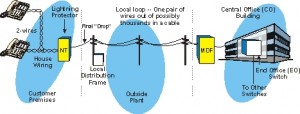Providing local telephone service may seem fairly simple on the surface. Your phone rings, you answer it, and carry on a conversation with a neighbor, a relative in another state, or perhaps a friend in a foreign country. That simple phone call whether it be across the street, to another state, or across oceans takes very sophisticated equipment and software, designed to provide reliable service 99.999% of the time.
All of the ability to connect callers, begins and ends with what we call the “local loop”.
The diagram below provides a simplified picture of how TDS Telecom and telephone companies provide service to customers. The local loop ends at the NID (Network Interface Device), which provides protection from lightning and enables the connection of the drop to the customer’s wiring inside their house or place of business. Within the house, all phones are connected to the same pair of wires, in a parallel manner, which allows dial tone to be present on all phones and for all of those phones to ring at the same time when a call comes in.
If one of those phones goes bad, or a problem develops on the wiring to one or more phones, it will affect the service to all phones in the house.
Tip: A good way to find out if you’re having problems inside or outside your house is to take a regular phone to the NID, unplug the silver cord, and plug the phone into that phone jack. If you have dial tone, then the problem is outside your home, and when you call to report the problem, you can tell the person who creates your trouble ticket that you have dial tone at the NID. That information makes it easier for our technicians to find and repair the problem with your phone service.
The drop for your local service is connected to pair of wires in a larger cable (outside plant) that eventually is connected to our Central Office (CO). The yellow MDF box illustrates the Main Distribution Frame located in the CO. Cables from the outside are connected to this frame, as well as cables from the switching equipment in the CO. We run jumpers from the pairs in the switching equipment cables to the pairs in the outside cables to provide dial tone to our customers. The end result, is that one pair of wires from the CO switching equipment is connected to one pair of wires in the outside cable to provide service to your home or place of business.
The central office switching equipment (show below) is the main hub for all telephone service within a particular exchange. The equipment provides dial tone, routes your calls to the destination you dialed, receives incoming calls and sends them to you, and provides all the other services, such as call waiting, call forwarding, caller id name and number, as well as all the other features that you and others have come to rely on.

In my next blog posting, I will talk about how we get your calls to other towns, states, and countries. Feel free to ask me questions or tell me what you want to learn more about.



Hello Rick,
Please, allow me to ask a few questions:
1) How do telephone signals travel, say from a caller calling from a landline phone, to another caller who lives on a different continent? I would like to know the connections involved at each point of the transmission of the signals right from the caller’s end to the person receiving the call. Is a part of the transmission served by cable wires while the rest is served by a ground station instrument that transmits the signals to a satellite or what? If so, is there a cable coming from the caller’s telephone that connects directly with the satellite or what? Furthermore, where do the signals pass through successively before it finally reaches the person at the other end who receives the call. I would appreciate a good diagram to illustrate the complete path or “circuit” taken by the signal at each point before it finally reaches the other end of the call.
2) In what way would the signal transmission be different if the caller were using a mobile phone to make the call to a very far destination?
3) If calling a not too distant destination, would a satellite be involved in the transmission?
4) Finally, what’s the nature of the telephone signals? Is it radio waves, electric current, or what? How does it differ from internet signals? Are internet signals a kind of electromagnetic waves or what? What’s the nature of internet signals/
I’d really appreciate it if you could help me to better understand these issues.
Thanks.